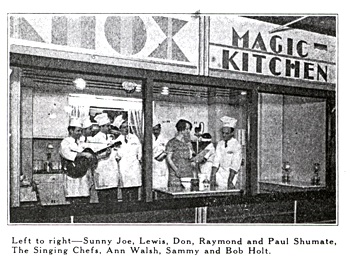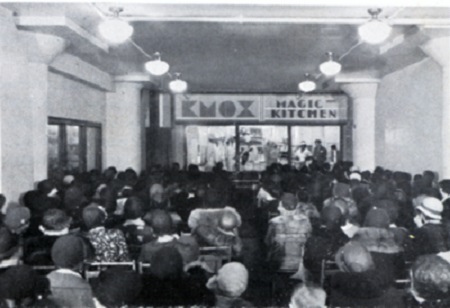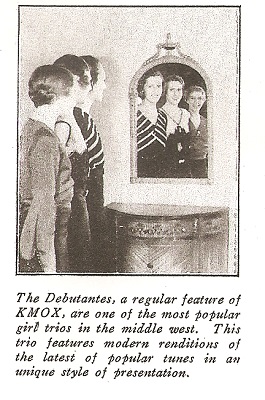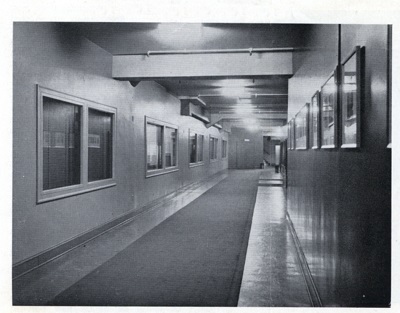Broadcasts from the new General Electric kitchen recently installed at KMOX are heard every morning at 11 o’clock when Ann Walsh, Home Economics expert, gives recipes, menus and household hints.
The foods made from recipes that call for Omega Flour and David G. Evans products are actually cooked in the studio during the broadcasts and Miss Walsh describes the results as they take place. The Singing Chefs, the four Schumate Brothers and Sunny Joe and his banjo supply the musical interludes in the programs.
(Originally published in Radio and Entertainment 4/1/33).
KMOX Kitchen Interests Women Everywhere In USA, Including Mrs. Roosevelt
(By Meryl Freidel)
Old adages are sometimes trite and tiresome, but very often true. The one about “make a better mousetrap…” – you know it…is again proven true by the KMOX Magic Kitchen which, in the short space of five months has won national recognition for its new and unusual manner of teaching home economics to both and air and a visible audience at one and the same time. It is the only actually-in-operation radio electric kitchen in the Midwest.
Only a few short weeks after its beginning, the Magic Kitchen began to receive letters from all parts of the country, from other radio stations and from home economics schools, asking full details about the KMOX enterprise so that they might start a similar one in their cities. About a month ago, Mrs. Franklin D. Roosevelt sent a personal letter to Ann Walsh, director of the kitchen, commending the work of the kitchen and enclosing one of her own favorite recipes to be made in the kitchen and passed on to its audience. Last week, the National 4-H Club for girls affiliated itself with kitchen through Miss Alice Classen, County Leader of the 4-H Club of St. Clair County. Miss Classen, declaring that the kitchen was an inspiration to the girls and a long sought opportunity to show interested homemakers just what the girls learn in the club is, each week, bringing a different group of six members of the club to the kitchen where they demonstrate in complete detail, methods of canning, various kinds of cooking, baking and so on.
 The picture of the KMOX Magic Kitchen and its auditorium shown here gives only the very faintest idea of this unusual broadcast program and its setting. The kitchen itself, all glass-enclosed, is all electric, showing and using the latest in household appliances. The auditorium in front of it seats about three hundred persons and is filled to capacity every day during the program. Housewives come from far and near to inspect the kitchen’s many labor-saving devices and new accoutrements for better and easier housekeeping and cooking.
The picture of the KMOX Magic Kitchen and its auditorium shown here gives only the very faintest idea of this unusual broadcast program and its setting. The kitchen itself, all glass-enclosed, is all electric, showing and using the latest in household appliances. The auditorium in front of it seats about three hundred persons and is filled to capacity every day during the program. Housewives come from far and near to inspect the kitchen’s many labor-saving devices and new accoutrements for better and easier housekeeping and cooking.
During the program, which is broadcast daily except Sunday from 11:15 a.m. to 11:45 a.m., Ann Walsh presents various new house keeping suggestions and a number of novel recipes, of which one is prepared in the kitchen each day as it is given. Several valuable prizes are distributed daily among the auditorium audience which, after the broadcast, personally inspects the Magic Kitchen…with many Ohs and Ahs of delight and amazement…and samples the particular recipe prepared that day.
Although originally started as a sustaining service to its listeners by the station, the Magic Kitchen received such instantaneous response from housewives all over the country that manufacturers of foods and household appliances asked to be represented during this unusual feature, with the result that six such national manufacturers now have their products demonstrated in the kitchen.
(Originally published in Radio and Entertainment 7/8/1933).
Ann Walsh Dresses The Part On Home Economics Programs
Do you think that a crisp, white apron and a jaunty cap put you more in the mood for trying out delicious recipes?
Ann Walsh, home economics expert at KMOX, wears them when she stands before the microphone to talk confidentially to you about home planning and cooking. She says that is one of her chief cooking secrets, for when she goes into the kitchen, she likes to dress the part. It puts her more in the spirit for experimenting with the ingredients that make up the dainties she suggests to you over the air.
Even when she was a little girl and invited her playmates in for tea parties, she liked to wear becoming aprons and be a very correct hostess. A great number of her recipes come from a huge loose-leaf scrap book about good things to eat that she has been keeping since those make-believe days.
Long before little and red-haired Miss Walsh became known to her listeners as a cooking authority, she was behind the scenes so to speak in the varied, versatile capacities that are to be found in a radio station. She came to KMOX five years ago when George Junkin was director and did fifteen-minute singing programs presenting ballads and popular songs in a style all her own.
She remembers only two things about the first six months of her association there. She was frightened to death of Mr. Junkin and she adored him, as did everyone else at the station.
Her next step was that of studio director, when getting people in and out of audition rooms at the right time and seeing that everything was in readiness for the broadcasts were part of her worries. Going on the air in speaking parts was a gradual process and she hated it at first. When home economics became a greater feature, the news leaked out that she knew about good things to eat, which were almost total mysteries to everyone else, and she was chosen to direct this department.
Her career was almost nipped in the bud, however, for one night when a local soloist was to sing, she forgot to have an accompanist there. Mr. Junkin had already started to announce the numbers, and Miss Walsh pushed the protesting singer into the room and ran in search of a pianist. She was much too frightened to admit her error but scurried madly about to find someone to play. Before she returned, the director had seen the plight and heard Mrs. H. Carey Korndoerfer playing a one-finger accompaniment and had diverted the program.
She tells that as the worst of her radio experiences.
Letters asking about every conceivable thing in home management come to her from listeners, and she says that is the most gratifying part of talking to the unseen friends. She likes to feel that she is helping women in their homes with these aids that come from her own experiments and from scientific investigation.
(Originally published in Radio and Entertainment 3/19/1932).
 A new trio made its appearance to the radio audience of KMOX, The Voice of St. Louis, last Sunday at 10:15 a.m. The trio to which we refer is “The Debutantes” whose vocal harmonies attracted so much attention on Sunday’s broadcast that the telephones of KMOX were kept busy for hours answering calls from the inquiring audience who wanted to know just who these three girls really were.
A new trio made its appearance to the radio audience of KMOX, The Voice of St. Louis, last Sunday at 10:15 a.m. The trio to which we refer is “The Debutantes” whose vocal harmonies attracted so much attention on Sunday’s broadcast that the telephones of KMOX were kept busy for hours answering calls from the inquiring audience who wanted to know just who these three girls really were.

 The picture of the KMOX Magic Kitchen and its auditorium shown here gives only the very faintest idea of this unusual broadcast program and its setting. The kitchen itself, all glass-enclosed, is all electric, showing and using the latest in household appliances. The auditorium in front of it seats about three hundred persons and is filled to capacity every day during the program. Housewives come from far and near to inspect the kitchen’s many labor-saving devices and new accoutrements for better and easier housekeeping and cooking.
The picture of the KMOX Magic Kitchen and its auditorium shown here gives only the very faintest idea of this unusual broadcast program and its setting. The kitchen itself, all glass-enclosed, is all electric, showing and using the latest in household appliances. The auditorium in front of it seats about three hundred persons and is filled to capacity every day during the program. Housewives come from far and near to inspect the kitchen’s many labor-saving devices and new accoutrements for better and easier housekeeping and cooking. The floors of radio station KMOX are all covered with serviceable floor coverings: rubber tile, asphalt tile, rubber and linoleum. The KMOX Playhouse has carpeting in the area used for the seating of audiences and the center portion of the main corridor is carpeted. Mr. L.C. Burrows, Maintenance Engineer for KMOX, has a crew of five men under the supervision of Mr. J.L. Scherder who takes excellent care of the floor services.
The floors of radio station KMOX are all covered with serviceable floor coverings: rubber tile, asphalt tile, rubber and linoleum. The KMOX Playhouse has carpeting in the area used for the seating of audiences and the center portion of the main corridor is carpeted. Mr. L.C. Burrows, Maintenance Engineer for KMOX, has a crew of five men under the supervision of Mr. J.L. Scherder who takes excellent care of the floor services.